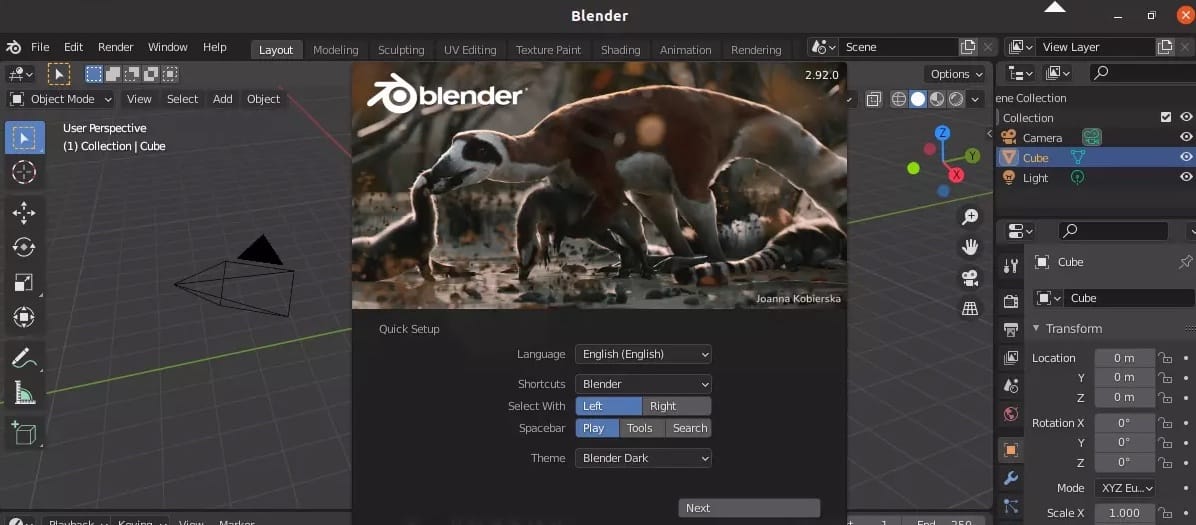How To Install Blender on AlmaLinux 9

Blender, the powerful open-source 3D creation suite, has become an essential tool for artists, animators, and designers worldwide. Its versatile features, including modeling, rigging, animation, simulation, rendering, compositing, motion tracking, and video editing, make it a go-to choice for professionals and enthusiasts alike. For users seeking a stable and enterprise-ready Linux distribution, installing Blender on AlmaLinux 9 is an excellent option. In this comprehensive guide, we will walk you through the step-by-step process of installing Blender on AlmaLinux 9, ensuring that you can harness its full potential for your creative projects.
What is Blender?
Blender is a free and open-source 3D creation suite that offers a wide range of tools for creating stunning visual content. Its feature-rich environment allows users to create 3D models, rig characters, animate scenes, simulate physics, render photorealistic images, compose visual effects, track motion, and edit videos. Blender’s community-driven development ensures that it constantly evolves and improves, making it a reliable choice for professionals in the industry.
System Requirements
Before installing Blender on AlmaLinux 9, it’s crucial to ensure that your system meets the minimum hardware requirements. While Blender can run on a variety of hardware configurations, the following specifications are recommended for optimal performance:
- Processor: 64-bit quad-core CPU with SSE2 support
- Memory: 8 GB RAM or higher
- Graphics Card: OpenGL 3.3 compatible GPU with 2 GB RAM
- Storage: 2 GB of free disk space
Keep in mind that these are the recommended specifications, and Blender can still run on systems with lower hardware configurations. However, for the best experience and to ensure compatibility with AlmaLinux 9, meeting these requirements is highly advised.
Preparation Before Installation
Before diving into the installation process, it’s essential to prepare your AlmaLinux 9 system to ensure a smooth and successful installation of Blender.
Updating AlmaLinux
To begin, update your AlmaLinux 9 system to the latest version. This step is crucial for maintaining system security and compatibility. Open the terminal and run the following commands:
sudo dnf update
sudo dnf upgrade
These commands will update the package repositories and upgrade any outdated packages to their latest versions. Ensure that you have a stable internet connection during this process.
Installing Required Dependencies
Blender relies on certain dependencies and libraries to function properly. Before installing Blender, you need to install these dependencies using the package manager. Run the following command in the terminal:
sudo dnf install libXi libXrender mesa-libGLU libXxf86vm libXfixes libXcursor libXinerama libglvnd-devel libXi-devel
This command will install the necessary dependencies, including libraries for rendering, OpenGL, and input handling.
Methods to Install Blender
There are multiple methods to install Blender on AlmaLinux 9, each with its own advantages. Let’s explore these methods in detail.
Install from Official Binary
The most straightforward method to install Blender on AlmaLinux 9 is by downloading the official binary from the Blender website. Follow these steps:
- Visit the official Blender website.
- Download the latest stable release of Blender for Linux.
- Open the terminal and navigate to the directory where you downloaded the Blender archive.
- Extract the archive using the following command:
tar -xf blender-*-linux-*.tar.xz
- Move the extracted directory to the
/optdirectory:
sudo mv blender-*-linux-* /opt/blender
- Create a symbolic link to the Blender executable:
sudo ln -s /opt/blender/blender /usr/local/bin/blender
By following these steps, you will have successfully installed Blender from the official binary. This method ensures that you have the latest stable version of Blender with all the latest features and improvements.
Using Package Manager
Another way to install Blender on AlmaLinux 9 is by using the package manager. While this method is convenient, it’s important to note that the version available in the package repositories may not always be the latest. To install Blender using the package manager, run the following command:
sudo dnf install blender
The package manager will handle the installation process, including the resolution of dependencies. However, keep in mind that the version installed through this method may be slightly outdated compared to the official binary.
Install via Snap
Snap is a package management system that allows you to install applications in a sandboxed environment. AlmaLinux 9 supports Snap out of the box, making it a convenient option for installing Blender. To install Blender using Snap, follow these steps:
- Ensure that Snap is installed on your AlmaLinux 9 system. If it’s not already installed, run the following command:
sudo dnf install snapd
- Enable the Snap service:
sudo systemctl enable --now snapd.socket
- Install Blender using the Snap command:
sudo snap install blender --classic
The --classic option allows Blender to access system resources outside the sandbox.
Using Snap to install Blender offers the advantage of automatic updates. Whenever a new version of Blender is released, Snap will automatically update your installation to the latest version.
Running Blender
Once you have successfully installed Blender on AlmaLinux 9, you can launch it from the terminal by simply typing:
blender
Alternatively, you can find Blender in the applications menu under the “Graphics” category.

When running Blender for the first time, you may want to configure some basic settings to suit your preferences. You can access the preferences by going to “Edit” > “Preferences” within Blender.
To optimize Blender’s performance on AlmaLinux 9, consider the following tips:
- Ensure that your graphics drivers are up to date.
- Allocate sufficient memory to Blender in the preferences.
- Enable GPU rendering if your graphics card supports it.
- Close unnecessary background applications to free up system resources.
Troubleshooting Installation Issues
While the installation process for Blender on AlmaLinux 9 is generally straightforward, you may encounter some common issues. Here are a few troubleshooting tips:
- If Blender fails to start, ensure that you have installed all the required dependencies. Double-check that you have followed the installation steps correctly.
- If you encounter missing library errors, try updating your system and reinstalling the missing libraries using the package manager.
- If Blender crashes or exhibits strange behavior, try starting it from the terminal using the
blender --factory-startupcommand. This will launch Blender with default settings, helping you identify if the issue is related to your preferences or add-ons.
If you continue to face issues, consider seeking support from the Blender community forums or the official Blender documentation. There are many resources available online where experienced users can provide guidance and solutions to common problems.
Congratulations! You have successfully installed Blender. Thanks for using this tutorial for installing the Blender on your AlmaLinux 9 system. For additional help or useful information, we recommend you check the official Blender website.